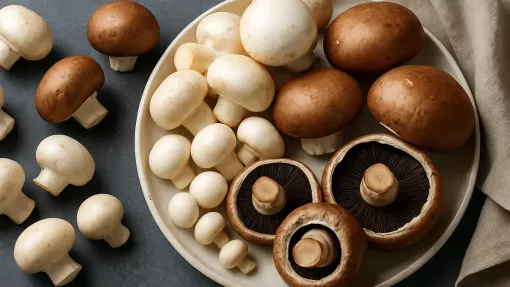Mushrooms

Mushrooms are an ingredient that offers a unique umami flavor, high nutritional value, and a wide range of culinary applications. They are suitable for both everyday meals and festive servings – whether fried, stewed, baked, or used in sauces and soups. Mushrooms pair well with vegetables, grains, dairy products, meat, and herbs. Learn more about salad ingredients in the main section.
Different Types of Mushrooms
Champignons: Versatile and Accessible
Champignons, or white button mushrooms, are the most widely cultivated mushrooms available year-round. They have a soft texture, neutral flavor with a slight nutty note, and absorb other ingredients' aromas well. They can be eaten raw, boiled, fried, stewed, baked, or stuffed. Champignons cook quickly and require no complex preparation. These mushrooms are commonly used in salads, pizzas, casseroles, sauces, omelets, and soups. They go well with eggs, cream, cheese, meat, and herbs. Thanks to their low calorie content and high protein concentration, champignons are popular in healthy diets. For example, champignon cream soup with cream and hard cheese is a hearty and delicate first course that is easy to prepare. Champignons are an ideal everyday option that easily adapts to any recipe.
Wild Mushrooms: Aroma, Seasonality, and Character
Wild mushrooms are a group of edible forest mushrooms, with the most popular being porcini, chanterelles, birch boletes, aspen boletes, slippery jacks, and honey mushrooms. They have a pronounced aroma, meaty or crunchy texture, and require thorough cleaning and thermal processing. Unlike champignons, wild mushrooms are seasonal – typically available from late spring to mid-autumn. These mushrooms are used for frying, stewing, baking, making soups, sauces, and as filling for pancakes or dumplings. They are also dried or pickled for winter. The aroma of porcini mushrooms is especially valued in European cuisine – both fresh and dried. For instance, stewed porcini mushrooms with onions, garlic, and sunflower oil make a rich, forest-scented dish suitable as a side or standalone dinner. Wild mushrooms add depth, complexity, and a natural essence to meals.
Oyster Mushrooms, King Oyster, and Other Cultivated Varieties
Besides champignons, other cultivated mushrooms are gaining popularity – oyster mushrooms, king oyster (eringi), shiitake, enoki, and others. They feature various textures: from delicate and silky to dense and crispy, as well as rich, meat-like flavor profiles. These mushrooms are high in protein, fiber, B vitamins, and antioxidants. Oyster mushrooms are great for frying, stewing, grilling, and baking. King oysters are often sliced and fried as “vegan steaks,” while shiitake are used in soups, stir-fries, and rice dishes. Thanks to their firm structure, these mushrooms hold their shape during cooking. For example, oyster mushrooms sautéed with onions, soy sauce, and chicken fillet make a quick and flavorful dish with an Asian twist. Cultivated mushrooms open up new possibilities for everyday meals regardless of the season.
Dried and Pickled Mushrooms: Preserving and Deep Flavor
Dried and pickled mushrooms are convenient ways to preserve the harvest and enjoy concentrated flavor year-round. Porcini, chanterelles, and birch boletes are most commonly dried. Before use, they are soaked in water for several hours, then added to soups, sauces, grains, or stews. The flavor and aroma of dried mushrooms are much more intense than fresh ones. Pickled mushrooms are ready-to-eat products ideal for appetizers, salads, and sandwiches. They are preserved in an acidic brine with spices, garlic, pepper, and bay leaves. Honey mushrooms, slippery jacks, oyster mushrooms, and champignons are often pickled. These mushrooms are convenient for festive tables or as snacks in daily menus. For example, a salad with pickled mushrooms, onions, beans, and buckwheat is a nutritious, simple, and aromatic dish that combines acidity, protein, and texture. Preserving mushrooms brings variety to the table in any season.
Mushrooms in Dishes: A Universal Ingredient
Mushrooms are one of the most versatile ingredients, fitting well into soups, sides, salads, pies, stews, sauces, and fillings. They pair with meat, grains, vegetables, eggs, cheese, and cream. Thanks to their rich umami flavor, mushrooms are often used as a meat substitute in vegetarian dishes such as mushroom patties, lasagna, pâtés, or stuffing for vegetables. Mushrooms are used in cuisines around the world – from French sauces to Japanese miso soups. In salads, they can be either the main component or an addition. They are added to pizza, pasta, cream soups, and casseroles. Though not used in desserts, they pair well with sweet-and-sour sauces and fruit in main dishes. For example, stewed champignons with onions, cream, and egg yolk make a delicious filling for crepes or tartlets. Mushrooms allow for the creation of rich, aromatic, and deeply flavored dishes.
